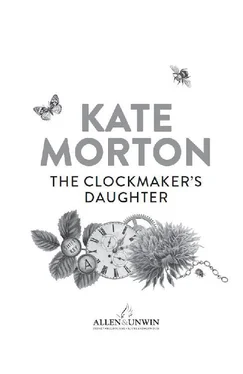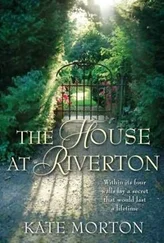Kate Morton - The Clockmaker's Daughter
Здесь есть возможность читать онлайн «Kate Morton - The Clockmaker's Daughter» весь текст электронной книги совершенно бесплатно (целиком полную версию без сокращений). В некоторых случаях можно слушать аудио, скачать через торрент в формате fb2 и присутствует краткое содержание. Год выпуска: 2018, Издательство: Allen & Unwin, Жанр: Старинная литература, на английском языке. Описание произведения, (предисловие) а так же отзывы посетителей доступны на портале библиотеки ЛибКат.
- Название:The Clockmaker's Daughter
- Автор:
- Издательство:Allen & Unwin
- Жанр:
- Год:2018
- ISBN:нет данных
- Рейтинг книги:4 / 5. Голосов: 1
-
Избранное:Добавить в избранное
- Отзывы:
-
Ваша оценка:
- 80
- 1
- 2
- 3
- 4
- 5
The Clockmaker's Daughter: краткое содержание, описание и аннотация
Предлагаем к чтению аннотацию, описание, краткое содержание или предисловие (зависит от того, что написал сам автор книги «The Clockmaker's Daughter»). Если вы не нашли необходимую информацию о книге — напишите в комментариях, мы постараемся отыскать её.
The Clockmaker's Daughter — читать онлайн бесплатно полную книгу (весь текст) целиком
Ниже представлен текст книги, разбитый по страницам. Система сохранения места последней прочитанной страницы, позволяет с удобством читать онлайн бесплатно книгу «The Clockmaker's Daughter», без необходимости каждый раз заново искать на чём Вы остановились. Поставьте закладку, и сможете в любой момент перейти на страницу, на которой закончили чтение.
Интервал:
Закладка:
Finding archival materials in the disused cloakroom, let alone so many decades after they’d apparently been delivered, was disquieting and Mr Pendleton’s reaction had been predictably explosive. He was a stickler for protocol, and it was lucky, Elodie and Margot later agreed, that whoever had been responsible for receiving the delivery in 1966 had long ago left his employ.
The timing couldn’t have been worse: ever since the management consultant had been sent in to ‘trim the fat’, Mr Pendleton had been in a spin. The invasion of his physical sphere was bad enough, but the insult of having his efficiency questioned was beyond the pale. ‘It’s like someone borrowing your watch to tell you the time,’ he’d said through frosted lips after the consultant had met with them the other morning.
The unceremonious appearance of the box had threatened to tip him into apoplexy, so Elodie – who liked disharmony as little as she did disorder – had stepped in with a firm promise to set things right, promptly sweeping it up and stashing it out of sight.
In the days since, she’d been careful to keep it concealed so as not to trigger another eruption, but now, alone in the quiet office, she knelt on the carpet and slid the box from its hiding place …
The pinpricks of sudden light were a shock, and the satchel, pressed deep inside the box, exhaled. The journey had been long, and it was understandably weary. Its edges were wearing thin, its buckles had tarnished, and an unfortunate musty odour had staled in its depths. As for the dust, a permanent patina had formed opaquely on the once-fine surface, and it was now the sort of bag that people held at a distance, turning their heads to one side as they weighed the possibilities. Too old to be of use, but bearing an indefinable air of historic quality precluding its disposal.
The satchel had been loved once, admired for its elegance – more importantly, its function. It had been indispensable to a particular person at a particular time when such attributes were highly prized. Since then, it had been hidden and ignored, recovered and disparaged, lost, found and forgotten.
Now, though, one by one, the items that for decades had sat atop the satchel were being lifted, and the satchel, too, was resurfacing finally in this room of faint electrical humming and ticking pipes. Of diffuse yellow light and papery smells and soft white gloves.
At the other end of the gloves was a woman: young, with fawn-like arms leading to a delicate neck supporting a face framed by short black hair. She held the satchel at a distance, but not with distaste.
Her touch was gentle. Her mouth had gathered in a small neat purse of interest and her grey eyes narrowed slightly before widening as she took in the hand-sewn joins, the fine Indian cotton and the precise stitching.
She ran a soft thumb over the initials on the front flap, faded and sad, and the satchel felt a frisson of pleasure. Somehow this young woman’s attention hinted that what had turned out to be an unexpectedly long journey might just be nearing its end.
Open me , the satchel urged. Look inside .
Once upon a time the satchel had been shiny and new. Made to order by Mr Simms himself at the royal warrant manufactory of W. Simms & Son on Bond Street. The gilt initials had been hand-tooled and heat-sealed with enormous pomp; each silver rivet and buckle had been selected, inspected and polished; the fine-quality leather had been cut and stitched with care, oiled and buffed with pride. Spices from the Far East – clove and sandalwood and saffron – had drifted through the building’s veins from the perfumery next door, infusing the satchel with a hint of faraway places.
Open me …
The woman in the white gloves unlatched the dull silver buckle and the satchel held its breath.
Open me, open me, open me …
She pushed back its leather strap and for the first time in over a century light swept into the satchel’s dark corners.
An onslaught of memories – fragmented, confused – arrived with it: a bell tinkling above the door at W. Simms & Son; the swish of a young woman’s skirts; the thud of horses’ hooves; the smell of fresh paint and turpentine; heat, lust, whispering. Gaslight in railway stations; a long, winding river; the wheat fragrance of summer—
The gloved hands withdrew and with them went the satchel’s load.
The old sensations, voices, imprints, fell away, and everything, at last, was blank and quiet.
It was over.
Elodie rested the contents on her lap and set the satchel to one side. It was a beautiful piece that did not fit with the other items she’d taken from the box. They had comprised a collection of rather humdrum office supplies – a hole punch, an ink well, a wooden desk insert for sorting pens and paperclips – and a crocodile leather spectacle case, which the manufacturer’s label announced as, ‘The property of L. S-W’. This fact suggested to Elodie that the desk, and everything inside, had once belonged to Lesley Stratton-Wood, a great-niece of the original James Stratton. The vintage was right – Lesley Stratton-Wood had died in the 1960s – and it would explain the box’s delivery to Stratton, Cadwell & Co.
The satchel, though – unless it was a replica of the highest order – was far too old to have belonged to Ms Stratton-Wood; the items inside looked pre-twentieth century. A preliminary riffle revealed a monogrammed black journal (E. J. R.) with a marbled fore-edge; a brass pen box, mid-Victorian; and a faded green leather document holder. There was no way of knowing at first glance to whom the satchel had belonged, but beneath the front flap of the document holder, the gilt-stamped label read, ‘James W. Stratton, Esq. London, 1861’.
The document holder was flattish and Elodie thought at first that it might be empty; but when she opened the clasp, a single object waited inside. It was a delicate silver frame, small enough to fit within her hand, containing a photograph of a woman. She was young, with long hair, light but not blonde, half of which was wound into a loose knot on the top of her head; her gaze was direct, her chin slightly lifted, her cheekbones high. Her lips were set in an attitude of intelligent engagement, perhaps even defiance.
Elodie felt a familiar stirring of anticipation as she took in the sepia tones, the promise of a life awaiting rediscovery. The woman’s dress was looser than might be expected for the period. White fabric draped over her shoulders and the neckline fell in a V. The sleeves were sheer and billowed, and had been pushed to the elbow on one arm. Her wrist was slender, the hand on her hip accentuating the indentation of her waist.
The treatment was as unusual as the subject, for the woman wasn’t posed inside on a settee or against a scenic curtain as one might expect in a Victorian portrait. She was outside, surrounded by dense greenery, a setting that spoke of movement and life. The light was diffuse, the effect intoxicating.
Elodie set the photograph aside and took up the monogrammed journal. It fell open to reveal thick cream pages of expensive cotton paper; there were lines of beautiful handwriting, but they were complements only to the many pen and ink renderings of figures, landscapes, and other objects of interest. Not a journal, then: this was a sketchbook.
A fragment of paper, torn from elsewhere, slipped from between two pages. A single line raced across it: I love her, I love her, I love her, and if I cannot have her I shall surely go mad, for when I am not with her I fear —
The words leapt off the paper as if they’d been spoken aloud, but when Elodie turned over the page, whatever the writer had feared was not revealed.
She ran her gloved fingertips over the impressions of the text. When held up to the last glimmer of sunlight, the paper revealed its individual threads, along with tiny lucent pinpricks where the sharp nib of the fountain pen had torn across the sheet.
Читать дальшеИнтервал:
Закладка:
Похожие книги на «The Clockmaker's Daughter»
Представляем Вашему вниманию похожие книги на «The Clockmaker's Daughter» списком для выбора. Мы отобрали схожую по названию и смыслу литературу в надежде предоставить читателям больше вариантов отыскать новые, интересные, ещё непрочитанные произведения.
Обсуждение, отзывы о книге «The Clockmaker's Daughter» и просто собственные мнения читателей. Оставьте ваши комментарии, напишите, что Вы думаете о произведении, его смысле или главных героях. Укажите что конкретно понравилось, а что нет, и почему Вы так считаете.












